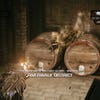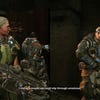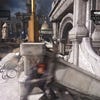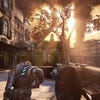Digital Foundry vs. Gears of War: Judgment
Baird necessities.
With Epic Games hard at work on a showcase Unreal Engine 4 title for next-gen platforms, it falls to satellite studio People Can Fly to give the current engine one last victory lap on existing console hardware. We've already seen Sony pushing the PS3 to incredible feats in recent months, but for the Xbox 360, the series that has consistently reflected the console's technical virtues has been Gears of War.
Casting our eyes back to 2006, it was the series' debut that had gamers dropping jaws over its intricate HD visuals and cutting-edge effects. Since then, for every new entry in Marcus' chainsaw-wielding odyssey, we've been given a grand tour of what's possible with the latest rendering technologies grafted into Unreal Engine 3. From meat blocks to increasing numbers of on-screen Locust, these titles are a roadmap of the engine's progress, showing the development community what they can achieve with the very same tools.
But the question is, does Gears of War: Judgment follow suit and bring something new to the table, or has the roll-out of new visuals features finally dried up? Even in late 2011 we saw Gears of War 3 mixing things up by removing multi-sample anti-aliasing (MSAA); a move which allowed the 360 to free its GPU cycles up for superior lighting and textures plus a more consistent 30FPS refresh. It was a worthwhile improvement on the whole, and really showed what Unreal Engine 3 was capable of - especially when development could focus singularly on the Xbox 360 hardware. However, even then, the advances stood as marks of evolution rather than outright revolution, the suggestion being that UE3 had hit the ceiling of its capabilities on current-gen hardware.
So let's lay all cards on the table: Judgment is very much your game if you love the core, meaty mechanics of Gears of War. If you love Horde mode. If you love the arcade-style scoring systems of the People Can Fly's wacky billiards-with-guns FPS, Bulletstorm. It offers up a campaign built around surviving in one walled-off arena in a turret defense fashion, racking up points, and then moving on to the next without so much as a boss battle or ride on the back of a giant Brumak. In other words, the grand set-piece moments that peppered Gears of War 3's adventure are shorn in favour of a tighter formula. But despite conceptually rooting its feet firmly to the ground, Judgment still manages to rank among the most visually breathtaking shooters we've played this generation.
"Despite conceptually rooting its feet firmly to the ground, Judgment still manages to rank among the most visually breath-taking shooters we've played this generation."
Within a mission, it's apparent People Can Fly has pushed for some of the largest and most richly coloured stages we've yet seen in the series - carrying over the punchy visual flair that distinguished its previous shooter. The smoggy industrial complexes and ruined mansions remain, but they're framed by beautifully animated sky-boxes that point to a bigger conflict, while the architecture looks crystal clear, untouched, and often over-run by thick floral outcrops. Geometry isn't just flat and polygonal, but intricate and ornate. Gothic statues, flapping COG banners and textured glass which arches over buildings each stand as highlights in later Wharf District levels.
This is all achieved without any texture pop-in or noticeable LOD transitions. The only fault we can pick out here is an issue streaming textures while turning around tight corridors specifically, which reveals a white flicker for a split second on the oncoming bend. It's mostly negligible, and if these level segments are designed to hide loading screens, they work as a fine replacement for a dull splash-screen. Otherwise, new missions are loaded in during Judgment's end-of-level sequences - 10-second cut-scenes involving Baird's squad pushing road-blocks or kicking open doors.
These are simple filler segments, and the only in-engine cut-scenes used throughout the game. The rest of the story is told through Bink-encoded FMVs for the trial scenes, which positions each mission as a unique "testimony" for every character. Pre-rendered assets usually get us groaning about macro-block artifacting - compression issues that come with the territory of fitting everything onto limited DVD-9 media, and a particular bugbear on previous Gears instalments. In all, Judgment's videos take up 2.44GB on disc and we're pleased to find quality is high enough to avoid any apparent issues. Their look is generally smoother and more processed than the main game's, with the cinematic 2.35:1 presentation and lack of aliasing being the two giveaways. Otherwise, the game rarely takes control out of your hands, delivering most other beats in the story through a character's running monologue.
"Other effects are of sky-high quality, from the fluid simulations on blood splatter and the lambent Locust's toxic spills, to the water shader and mortar fire alpha effects during the impressive Normandy landing-style siege."
Regarding anti-aliasing, Judgment appears to offer a post-process solution, with Nvidia's FXAA known to be a fairly recent addition to the UE3 toolkit. The injection of colour into the series does mean jaggies flare up more visibly than they otherwise would, but the engine's post-processing helps to keep much of this at bay. We also see performance is on an even keel with Gears of War 3, showing a very committed lock to 30FPS that only gives out to excesses of alpha. Drops to 25FPS are possible while chainsawing through Locust grunts, but it's an uncommon sight, and the game's adaptive v-sync is at the ready to show screen-tear where any frame is overdue.
Tearing is difficult to pick out from the scene however, since much of it comes about while whipping the camera around at speed. The use of full-screen and object-based motion blur ends up masking this much of the time, leaving a string of gradients behind independently moving objects. From screen-grabs, this never appears quite as cinematic as its implementation in the God of War series on PS3, but in motion it's hugely effective in making 30FPS playback appear much smoother.
Other effects are of sky-high quality, from the fluid simulations on blood splatter and the lambent Locust's toxic spills, to the water shader and mortar fire alpha effects during the Normandy landing-style siege. Nothing appears pared back in resolution, though the toll is duly paid in torn frames once these populate the screen. Textures are also impressive across the board, with bump-mapped rubble and pre-baked bullet decals dotted around the walls of the Museum stage. There is bilinear filtering at work over the top, which separates ground textures into three cascades in front of a player; a mainstay of the series that, once again, only becomes a factor during brightly-lit levels.
"We get a strong implementation of the UE3 light-shaft tech in Judgment, streaming between tree branches and even the stained glass materials used for buildings - complete with a diffused effect."
Lighting in Unreal Engine 3 games as of late has been stand-out too, with light shafts making an appearance in games like Borderlands 2. We get a strong implementation of the effect in Judgment as well, streaming between tree branches and even the stained glass materials used for buildings - complete with a diffused effect. Elsewhere, a multi-pass approach to lighting also greatly benefits indoor scenes. This method involves independently mapping each directional and ambient light across the scene in separate buffers, layering up to create a natural final image. Shadows generated from strong spotlights also tend to blend well with the lighting mix, with no pixellation or dithering to the throw.
Destruction and dismemberment physics form a major part of the series' image: the way blood sprays outwards from a chainsaw's point of contact, and how gut chunks splatter across the floor on the final shotgun blast. It's a macabre spectacle, but one that makes the series stand out in style from the crowd. The rag-doll physics on downed enemies have grown less prominent since the first game, with few enemies even twitching as you walk over them. However, there is still decorative use of the physics engine elsewhere, with boxes and wine bottles tumbling over in the streets, plus the swaying hair physics on female squad member Sofia Hendrik.
It's disappointing to see a lack of destructible buildings make the cut this time around, where before we could narrow down pillars on multiplayer levels, such as the recurring favourite Blood Drive, for a tactical advantage. Instead, there's a very sparing use of destructible cover during single-player, by means of the wooden crates in the Soleno Villa stage. Rather than have parts of the environment crumble in pre-defined chunks to reveal an enemy, walls now simply swap in alternative textures, making the battlefield feel more static as a result.
Another disappointment is the abandonment of the 3D mode, which by and large was well optimised for 30FPS playback in Gears of War 3, through delivering a 640x720 image to each eye. This counted as a last-minute addition during production, so it's a shame that the tech wasn't given another run-out here. Epic has been known to collate a boat-load of metrics about how their titles are being played (via Xbox Live) so we can only assume that actual user take-up for the mode on Gears 3 wasn't high enough to see its return in Judgment.
"Overall visual quality fires on all cylinders and the striking level designs hold their own against the very best locales in Marcus' original adventures."
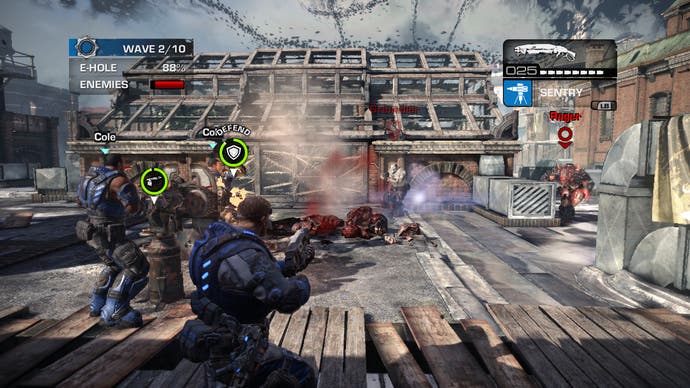
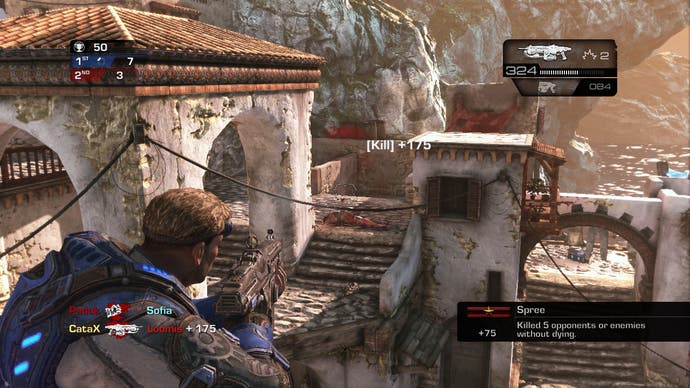

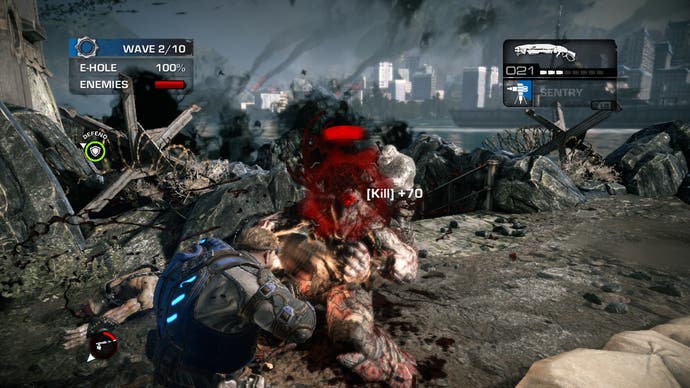
Gears of War: Judgment - the Digital Foundry verdict
All in all, developer People Can Fly has stirred up a beautiful looking game, built primarily around surviving waves of enemies in turret defense style scenarios. The issue here is the relative lack of cinematic ambition compared to the last game, designed by Epic Games itself to show off something of the full potential of its engine technology. There's a plainness to the campaign design when taken as a full-blown sequel to Gears of War 3, with much more of a focus on multiplayer. Looking at things rather brutally, if you're a single-player sort of guy, you're left with a package that's more akin to an expansion pack, with the bonus Aftermath chapter suitably striving to tie up loose ends in the mainline story.
Even so, Gears of War: Judgment is an encore worth investing in for other reasons. Technically speaking, spectacular set-pieces in the vein of the past two games' may have been thrown to the wayside, but the baseline action is delivered with the most up-to-date revision of the engine, and the core gunplay remains as engaging as ever. The effects work, lighting and overall visual quality all show the technology is still firing on all cylinders here, and to its great credit, the striking level designs hold their own against the very best locales in Marcus' original adventures. The focus on improving multiplayer also pays off handsomely if that's your bag, for all the reasons Dan Whitehead mentioned in the 8/10 Eurogamer review.
As current-gen consoles enters their twilight years, it's clear that technological progress has slowed, and there are few tricks left up Unreal Engine 3's sleeve. But the engine won't die with the 360 and PS3 - its future is bright on mobile, and the DirectX 11 Samaritan demo suggests that the middleware still has something to offer for next-gen platforms. In the here and now, the biggest leap forward we've seen in UE3 titles has been reserved for PC, with Kepler-based GPUs running PhysX bringing about a big visual boon to games like Borderlands 2, with its full cloth and fluid simulation. Looking forward, we suspect that many of the major enhancements to Epic Games' tech will be flooding in with the launch of its first Unreal Engine 4 title. But for now, it remains a mystery as to whether the Gears of War franchise will continue to reflect this technical progress well into the next generation, or if Judgment is a sign that it's priming an entirely new IP to fill those shoes.





